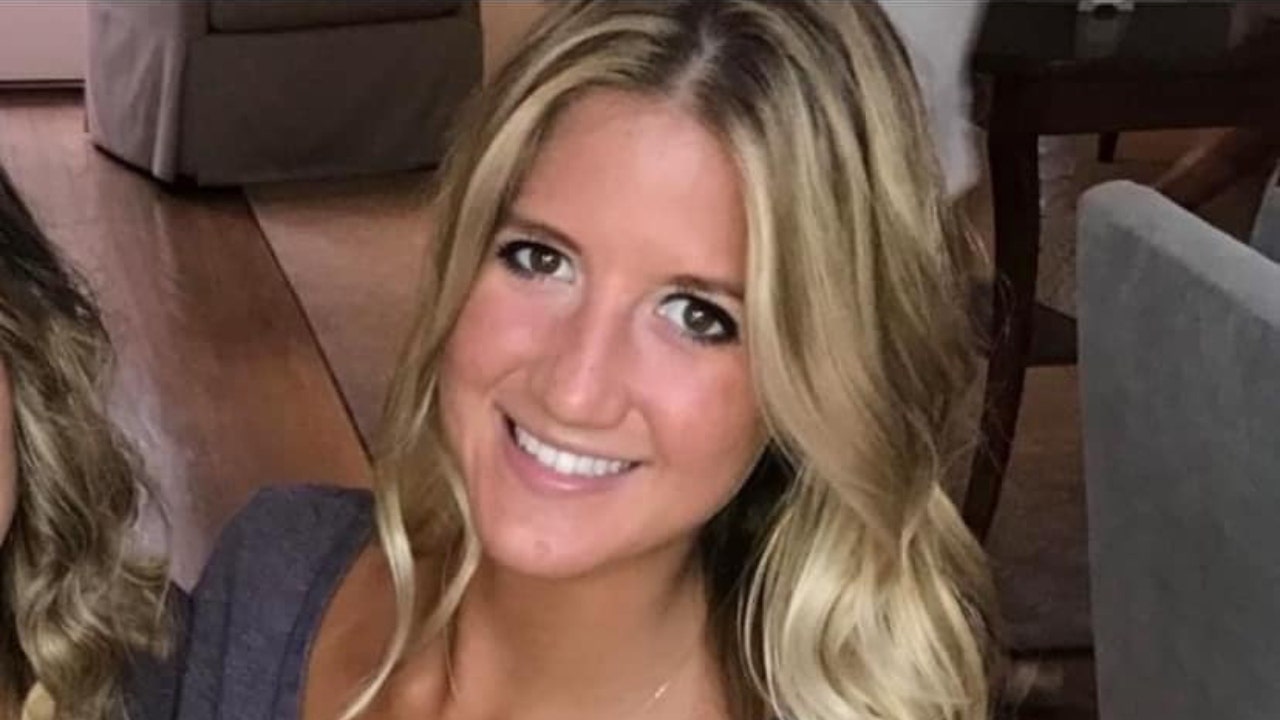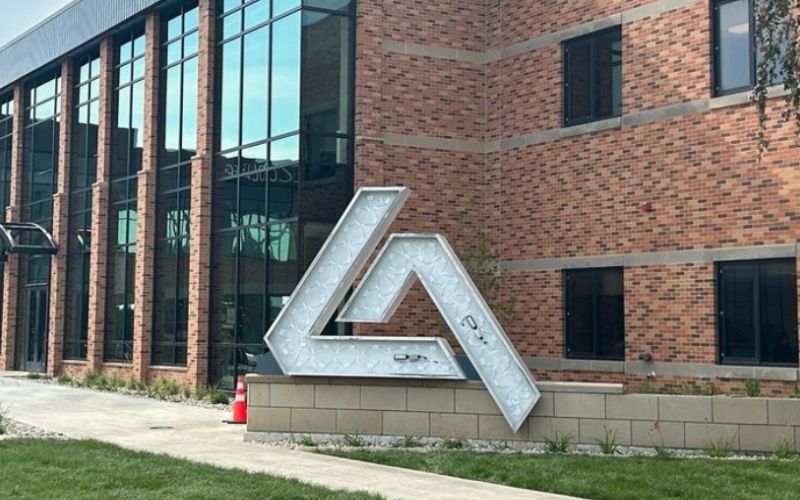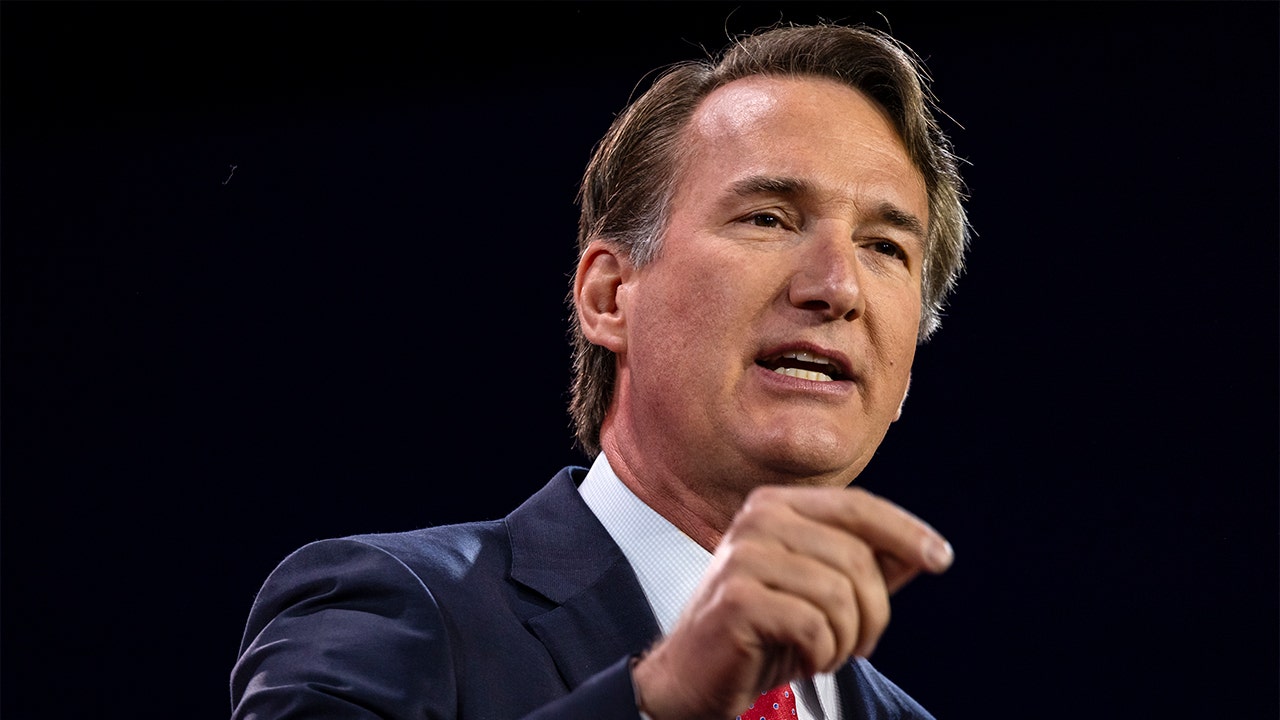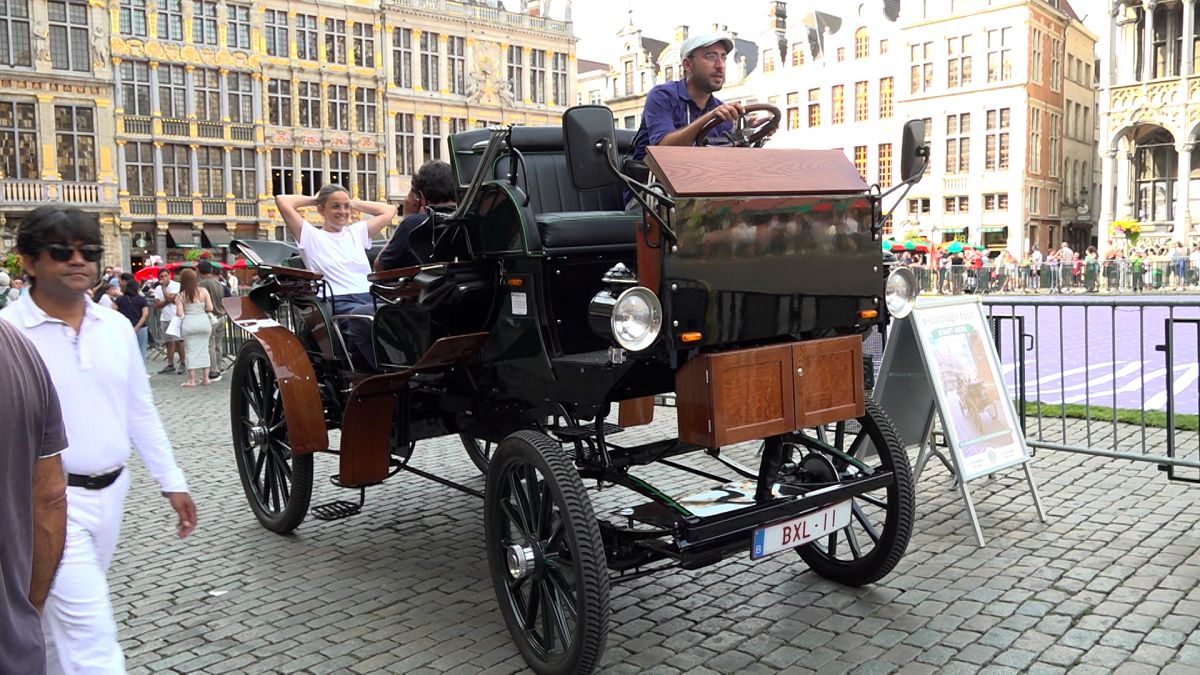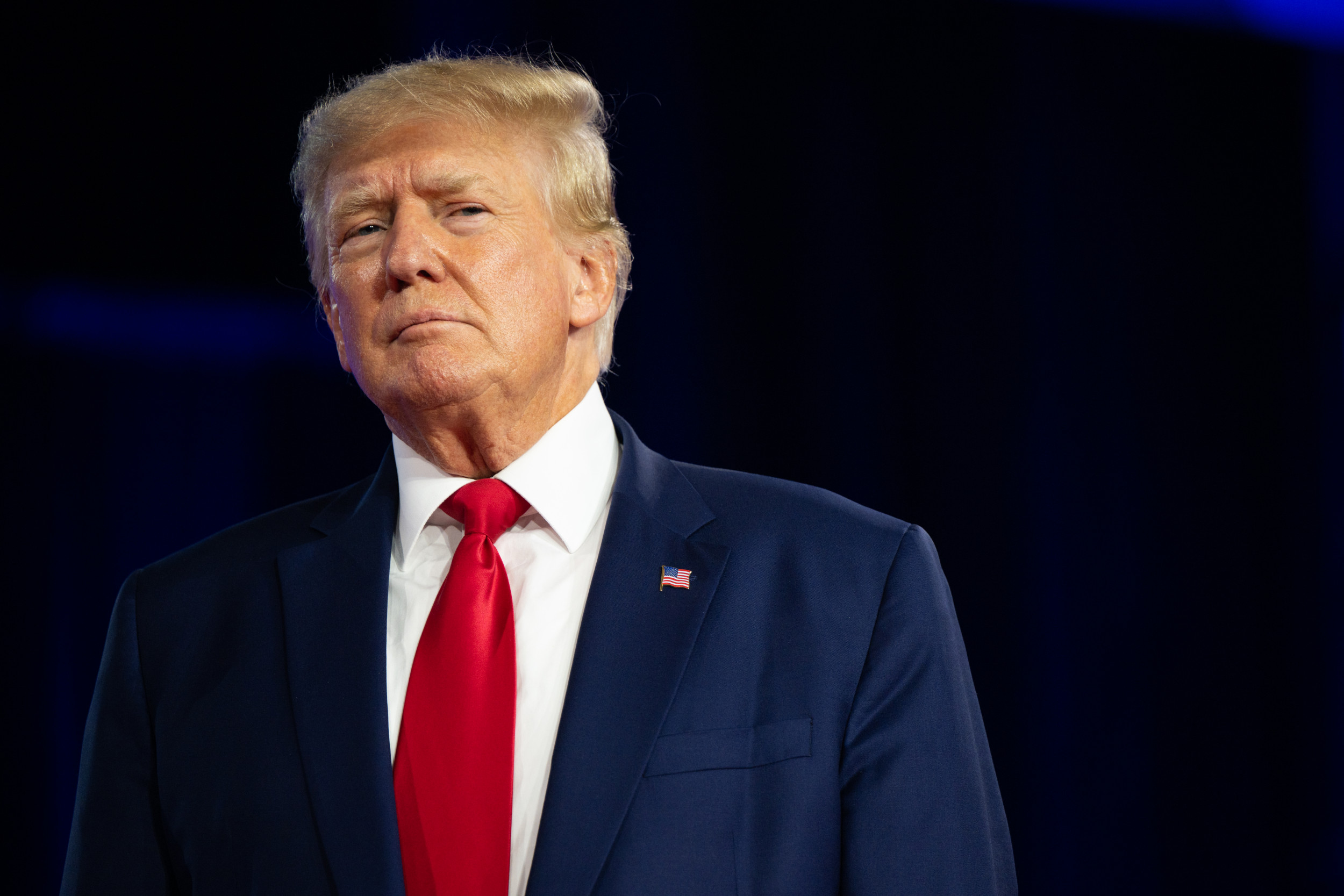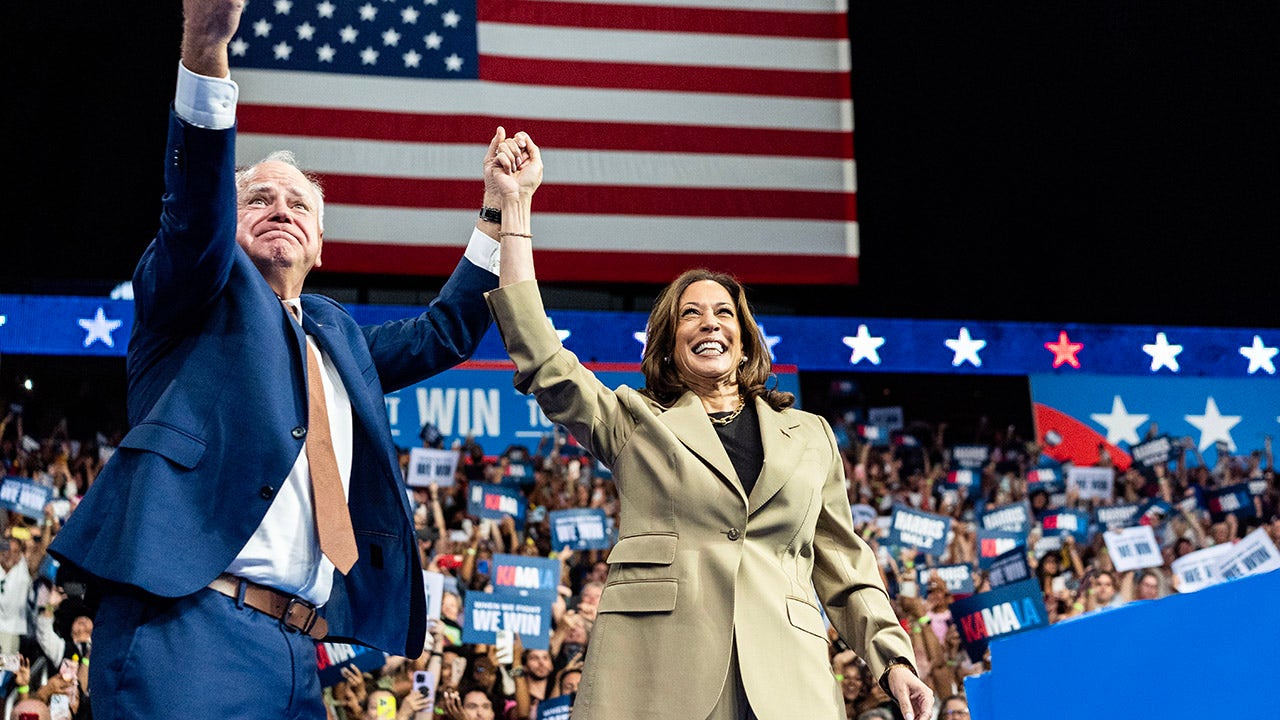Sports
Granderson: Tim Walz took a stand when queer kids needed an advocate
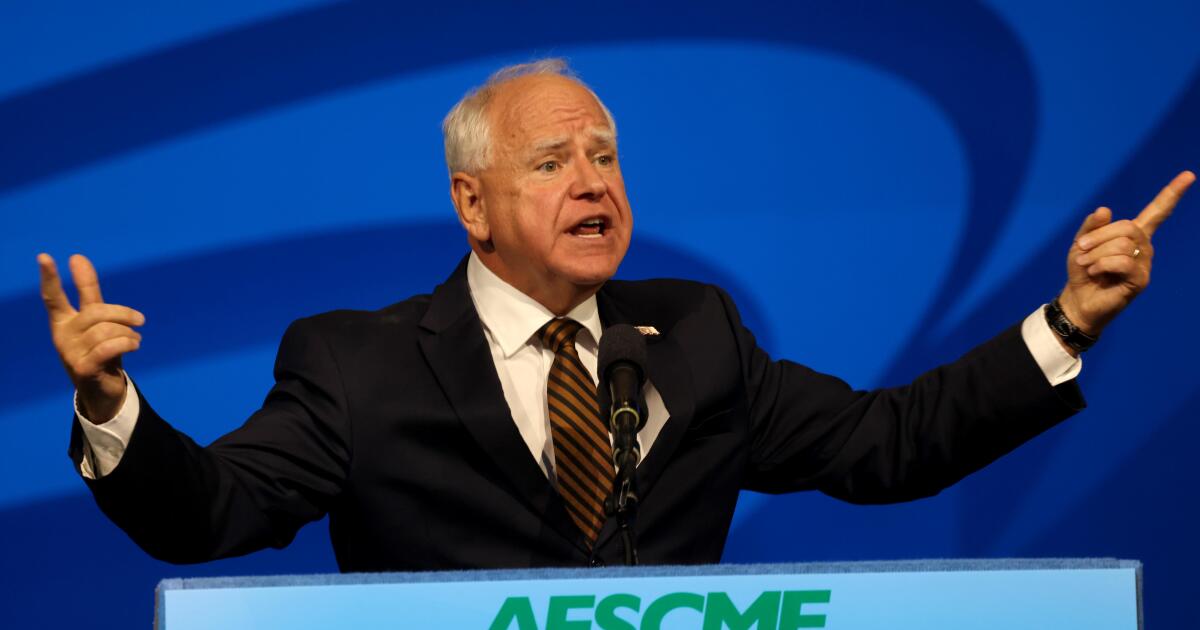
Harrison Butker, the Kansas City Chiefs player whose “Me Tarzan/You Jane” commencement speech caused an uproar last spring, was back in the news recently after signing a contract extension that made him the highest-paid kicker in the league. Well deserved, considering he’s the second most accurate in NFL history. Unfortunately, the occasion also provided an opportunity for him to double down on his remarks.
Opinion Columnist
LZ Granderson
LZ Granderson writes about culture, politics, sports and navigating life in America.
“I prayed about it, and I thought about it, and I was very intentional with what I said, and I stand behind what I said,” the 29-year-old told reporters last week.
Among the hits: calling diversity, equity and inclusion efforts “tyranny,” taking a swipe at President Biden’s faith and telling the graduating women, “I would venture to guess that the majority of you are most excited about your marriage and the children you will bring into this world.” Of his wife he said: “It cannot be overstated, that all of my success is made possible because a girl I met in band class back in middle school would convert to the faith, become my wife and embrace one of the most important titles of all: homemaker.”
It was like listening to a JD Vance demo track.
However, the three-time Super Bowl champion did say something back in May that resonated with me: “Be unapologetic in your masculinity. Fight against the cultural emasculation of men. Do hard things. Never settle for what is easy.”
To some, Butker’s words about masculinity seemed toxic, reflecting misogyny and homophobia. To others, his thoughts sounded like a much-needed response to the current landscape, which is shaped by what is deemed politically correct for men to say and do.
Butker’s words stuck with me because I too believe men should “do hard things.”
Where we disagree is on what the hard things are. A highly paid athlete using his platform to demonize initiatives that support minority and queer inclusion doesn’t seem brave to me. As the politician Sam Rayburn famously said: “Any jackass can kick down a barn, but it takes a good carpenter to build one.”
What it means to be a man in today’s America has been the focus of sociologists and conservative and progressive political pundits as well as politicians and podcasters. Some men, like Joe Rogan, have monetized the conversation. Some conservatives, like Sen. Tom Cotton of Arkansas and Vance of Ohio, are cosplaying some bygone myth of masculinity. And there are progressives who fall dangerously close to similar thinking, such as the strategist James Carville this March when he wagged an angry finger at “preachy females” in the Democratic Party.
Enter Tim Walz, governor of Minnesota and running mate of Vice President Kamala Harris.
Like Butker, he too loves football. And in 1999 while the Mankato West High School football team for which he coached was in the midst of a 2-4 start, Walz also became faculty advisor for the school’s first gay-straight alliance. For context: Matthew Shepard was found beaten and bloodied roughly 800 miles west in Laramie, Wyo., the year before. Billy Bean, the second former MLB player to come out, had not yet sat down with Diane Sawyer to talk publicly about his sexual orientation. Just 35% of the country supported same-sex marriage.
And there was Walz, a football coach in Small Town, USA, deciding to use his platform to help students who were being bullied. Later that year, the football team went on a winning streak and finished the season as state champions.
When I think of what it means to do the hard things, that’s as good of an example as any.
Among the Harris-Walz campaign stops this week was a fundraiser in Denver. There, several attendees told me how much they appreciated Walz being an ally long before it was trendy. This would include former student-athletes who were closeted during their playing days. When I asked Walz whether there had been any pushback for him supporting the LGBTQ+ students in his school, he said: “No, and that’s the thing I don’t think gets told. The community was accepting. It just had to be done.”
At the rally in Philadelphia at which Harris announced Walz as her running mate, she told the story of Walz volunteering as the GSA faculty advisor as well as that championship football season.
It was the kind of story Bean would have loved to have heard. Unfortunately, he died just hours before. Last fall, he was diagnosed with acute myeloid leukemia. Bean was 60 years old, the same age as Walz. Bean spent the last decade of his life trying to make the world of sports a more accepting space — as Major League Baseball’s senior vice president of diversity, equity and inclusion.
I’m sure Bean and countless others would have loved to have had a coach like Walz when they were growing up. Today’s queer athletes live in a world where allyship is becoming more the rule than the exception. This year, there were nearly 200 out queer Olympic athletes in Paris, with a third of them winning a medal.
Not sure how Butker feels about that showcase of diversity, equity and inclusion. As for me, I would like to think it’s the byproduct of a world in which men like Walz aren’t afraid of doing hard things.

Sports
Manchester City, the Premier League and the season everything might change

Welcome to the season when everything might change, or nothing might change, for the most popular football league on the planet. In the coming months, the hearing against Manchester City for their 115 alleged breaches of Premier League regulations will begin and a verdict is expected before the end of the campaign.
On Tuesday, in a season-opening interview with journalists, the Premier League’s chief executive, Richard Masters, insisted the competition organisers “actually have a pretty good working, operating relationship” with Manchester City. Yet that is a polite veil over an increasingly peculiar and toxic landscape for English football in which City, who have won four Premier League titles in a row, were “surprised” to find themselves accused by the Premier League of having cheated their way to the summit.
This summer, during numerous conversations with owners and executives who work or have worked within the Premier League, many speaking anonymously to protect relationships, the divergence of opinions and expectations has been revealing. The matter has been discussed informally between ownership groups within the Premier League and it is the subject of gossip in matchday boardrooms. Naturally, they speculate.
Some are so worn down by the decade-long pursuit of City that they fear Manchester City’s case may result in a financial settlement rather than a sporting penalty. Then some rival executives consider this outcome to be impossible and utterly outrageous, and say it would cast the death knell for financial sustainability not only within the English game but across European football.
As one Premier League club executive says: “The collective view I’ve heard is that an appropriate sanction would have to be a points deduction so substantial — we are talking here between 70 and 80 points — that it guarantees City a season in the Championship.”
Another of the sport’s leading figures suggests the punishment ought to be more creative, that many points could be deducted from City in each of the next three seasons, meaning the club’s chance of Champions League qualification would be severely restricted. Another compares the City case to that of the English rugby union side Saracens who, when Premiership champions in 2019, were deducted 35 points, hit with a £5.36million ($6.9m at current rates) fine and relegated to the second division owing to non-compliance with the league’s salary-cap rules.
A coach who came up against City has simply made his mind up about their guilt and argues they have not achieved their success with the same level of discipline as their rivals, but suspects it is too late now to truly remedy the matter. At the same time, there are fears that a failure to convict and punish City poses major questions about the Premier League’s ability to run itself, particularly with the prospect of an independent regulator still looming next year. Numerous club executives say their incentives to follow the rules would be greatly diminished if the Premier League proves toothless on City.
At this point, we should remember that Manchester City are contesting the charges. Upon learning of their alleged breaches in February 2023, City said they were “surprised” by the development. They also said they have a “comprehensive body of irrefutable evidence in support of its position” and added that they “looked forward to the matter being put to rest once and for all”. The alleged breaches are extensive and serious, relating to a period between 2009 and 2018 in which City won three Premier League titles and emerged as one of Europe’s strongest teams, as well as hiring Pep Guardiola, the most in-demand coach in world football, to lead the club from 2016.
City stand accused of failing to provide accurate financial information, “in particular with respect to its revenue (including sponsorship revenue)”; failing to disclose managerial payments during the Italian coach Roberto Mancini’s time at the club between 2009 and 2013; and breaching Premier League rules on profit and sustainability (PSR) between 2015 and 2018. The Premier League also argued City did not comply with UEFA — European football’s governing body — regulations around financial fair play in 2013-14 and between 2014-15 and 2017-18. The Premier League also claimed City did not cooperate fully with investigations in “the utmost good faith”.
City have been down this road before. They were banned from European competitions for two years by UEFA for alleged breaches of financial regulations in February 2020. Yet the sanction was overturned by the Court of Arbitration for Sport (CAS) in July of the same year when the court ruled “most of the alleged breaches were either not established or time-barred (outside of the organisation’s five-year statute of limitations)”. City were fined €10million (£8.6m; $11m) for not cooperating with the investigation.
In English football, nobody is prepared to put their name to quotes about the City case. That is not the same for La Liga president Javier Tebas, who has been a longstanding critic of the impact of clubs linked to nation-states. City always insist they are not owned by the state of the United Arab Emirates (UAE), but Sheikh Mansour bin Zayed Al Nahyan is the deputy prime minister of the UAE and the minister of presidential affairs. He is the majority shareholder in City via Newton Investment and Development, a company he wholly owns and which is registered in Abu Dhabi.
Tebas tells The Athletic: “It is difficult for me to say what is proportionate in England because I don’t know so well the English rules and law. But I can refer to what happened at UEFA… then what happened at CAS — in a resolution I would describe as a joke — is they took the sanction away. It was a very controversial decision to take away that sanction. Now, let’s see, I won’t dare to predict, but I am aware that there is a lot of concern among many clubs in the Premier League about what happens with City. What happens with Man City is a before and after moment for the Premier League itself.”
Javier Tebas is one of European football’s most powerful voices (Oscar J. Barroso/Europa Press via Getty Images)
The important thing to remember here is that the view of Tebas, or the many clubs in the Premier League to which he refers, will not be a factor in the final verdict. The Premier League has accused City of 115 alleged breaches, but the matter is now referred to a three-person independent commission for assessment. They are not known to the public but have been chosen by Murray Rosen KC, the barrister who is the head of the Premier League’s independent judicial panel.
A seasoned Premier League executive explains: “It is not the clubs that are prosecuting Manchester City. Unlike the American system, the clubs do not sit around in judgment of each other. They don’t decide whether to approve a new owner or not, like some American leagues. If you’ve got a case to answer, you’re going to have your day in front of an independent commission.”
While clubs will not have an input on the independent commission, The Athletic has previously reported how, in the years leading up to City being charged, rival clubs at both ownership and chief executive level would seek to impress onto the Premier League the need for progress on that matter. Sometimes it would be informal phone conversations, while legal letters and requests for information would also be sent. Very occasionally, clubs would seek an update within shareholders’ meetings, but for the most part, this became a topic executives pretended did not exist when sat together around the boardroom table.
Whenever they did ask for updates, clubs would be told by the Premier League that the case remained under investigation and nothing further could be said. Journalists have received the same answer. From a governance perspective, therefore, City’s rivals are powerless on this matter, reduced merely to lobbying around the edges. The pressure came more often from the top of the Premier League table, where bigger clubs argued to the Premier League hierarchy that they would have won more trophies if City had acted differently.
Yet over time, that anger has filtered across the division. When City sought to appeal against their UEFA ban from the Champions League at CAS, nine Premier League clubs wrote to express their objection to City’s sanction being suspended while they appealed. Some clubs then placed in the top half of the table opportunistically spied a place in European competition if City were out of the picture.

GO DEEPER
Man City charges: What do rival clubs make of the Premier League’s accusations?
Others across the Premier League do appear to genuinely believe the sport will be healthier if a firm deterrent is in place for financial regulations, while some clubs believe it is implausible, not least in terms of the optics for the Premier League, that City could evade punishment after Nottingham Forest and Everton received points deductions for financial breaches during the previous season.

GO DEEPER
Man City charges explained: The accusations, possible punishments and what happens next
“There is no happy alternative to enforcing the rules, which everyone has agreed at the beginning of each season,” Masters told Sky Sports News this week. “They have looked each other in the eye and shaken each other’s hand and said ‘We will abide by these rules’. So the Premier League has to enforce rules.”
There is also the question as to whether any political attempts have been made to exert pressure on the Premier League. Last year, the UK government admitted its embassy in Abu Dhabi and the Foreign Commonwealth & Development Office (FCDO) in London have discussed the charges levelled at Manchester City by the Premier League, but refused to disclose the correspondence. In response to a Freedom of Information request made by The Athletic, the government said it would risk the UK’s relationship with the UAE to do so. Manchester City did not comment when told about the existence of the correspondence and the Premier League declined to say whether it has received any correspondence from the UK government in relation to the matter.
The Athletic has previously detailed extensive official correspondence demonstrating a desire to impress the interests of the UK government on the Premier League, which has always denied it has been influenced in any way. There is no evidence to say the UAE government has made representations. Asked this week if the Premier League has ever felt pressure from foreign governments, Masters said: “Never, of any flavour or description. It just doesn’t happen.”
For the independent commission, there are reams of material to sort through. This all began when emails and documents emerged from Football Leaks and were published by German newspaper Der Spiegel in 2018. Those prosecuting City would claim the documents appeared to show City bypassing financial rules within football by disguising state investment as sponsorship revenues. City have always refused to comment on any of the German newspaper’s revelations because they say the leaks were “criminally obtained”.
During the hearing, both sides will be able to request the presence of any participants from the club or Premier League during the period in question. This may even extend to the Premier League calling upon Sheikh Mansour himself, but nobody can be compelled to attend the hearing. It would be a surprise if Mansour, as the deputy prime minister of the UAE, was to put himself in that position.
The same may be true of City chairman Khaldoon Al Mubarak. He is also the CEO of the $300billion Abu Dhabi Mubadala wealth fund — which owns some of City’s sponsors — as well as the chairman of the Abu Dhabi Executive Affairs Authority, which is described as a specialised government agency mandated to provide strategic policy advice to the Crown Prince Sheikh Mohamed. As such, several sources close to the Premier League suggested it would be unlikely that any figure directly linked to the state in the UAE would place their reputation on the line at a Premier League commission.

Sheikh Mansour (left) attended the Champions League final in June 2023 (Michael Regan – UEFA/UEFA via Getty Images)
The more likely scenario is that figures who have worked solely for City would attend the autumn hearing. Both sides have started preparing for cross-examination of witnesses, as to be expected with such an important hearing drawing near. One witness who had already been spoken to by City’s lawyers described the process as “hardcore”, “aggressive”, and “no-holds-barred”.
When it comes to making a decision, executives spoken to by The Athletic expect the commission to consider the offences in two parts. It will focus on the material alleged breaches, which could bring the most substantive penalties if City are found guilty, but then also the matter of alleged non-cooperation. Every person spoken to by The Athletic for this article said they expect City will face punishment for failing to cooperate, having previously received a fine for this from UEFA. The question is whether the commission judges non-cooperation to be worthy of a sporting penalty or merely a slap on the wrist.
These executives point out the contradiction in City’s public statement, where they said they welcomed the chance to present their irrefutable evidence but, at the same time, the Premier League charges include allegations that the club obstructed the investigation. City, for example, headed to court to question the league’s jurisdiction to investigate it and then once more, this time with the Premier League, to prevent any details from becoming public.
Lord Justice Stephen Males, a High Court judge who heard the latter case, wrote in his 2021 judgment: “This is an investigation which commenced in December 2018. It is surprising, and a matter of legitimate public concern, that so little progress has been made after two-and-a-half years — during which, it may be noted, the club has twice been crowned as Premier League champions.” Twice has now become five.
This is where the suggestion of a settlement between the Premier League and City appears to become less likely. “There’s been plenty of opportunity for settlements in the past, which hasn’t happened,” says one executive familiar with the case. “Either party can at any time effectively take it out of the court and have a conversation without prejudice to say we’ll have a settlement. But the further you go, the less likely that is.
“But the scale of this is so large that it’s really difficult to have a negotiated settlement. What are you going to settle on? A fine? A small number of points? Look at Forest and Everton. You can’t do that. This is of a scale both in terms of time, depth and severity of charges that is completely off the scale of the others.”
The desire for a settlement would need to come from City, too, and the biggest clue towards their approach came within one of City’s most infamous leaked emails when a leading City lawyer wrote that Al Mubarak, the club chairman, had said that “he would rather spend 30million on the 50 best lawyers in the world to sue them for the next 10 years” than agree to any financial settlement or penalty from UEFA amid the previous case.

Pep Guardiola, pictured here with Khaldoon Al Mubarak, is hoping to lead Manchester City to an unprecedented fifth straight Premier League title (Simon Stacpoole/Offside via Getty Images)
One Premier League executive says there is a feeling within the league’s HQ that City have simply “taken the p***” since receiving their first letter from the Premier League on the matter in 2018. This person argues that if City accepted some fault from the outset, they may have taken a substantially smaller punishment than the one which could now be imposed. “They wouldn’t have been relegated, but they have now dug themselves into the massive hole. And it’s either a massive leap that gets them out scot-free or a massive sanction. It is a Hail Mary.”
The implications of the City case reach far and wide. The Premier League is a phenomenal global success that now drives more in international television revenue than it does from its domestic deal. In the United States, the Premier League’s $450million-per-season deal with NBC dwarfs that of La Liga’s $175m package with ESPN, or Bundesliga’s $30m deal with ESPN. During an interview earlier this summer, The Athletic asked Jon Miller, NBC’s President, Acquisitions and Partnerships, whether the investigations not only into City but also Everton, Nottingham Forest and Chelsea in any way impacted the value of the Premier League.
Miller said: “It doesn’t question the value at all. What it says to me is that the people who are leading the Premier League very much are hands-on and they’re going to enforce their rules. It’s important that the league has got their hands around this and they’re not afraid to impose discipline where they think it’s needed.
“I actually applaud them for the stance they’re taking, even if it might move a team into a relegation zone or out of a Champions League or Europa League place. I would rather make sure the league is run on a fair basis, that everybody plays by the same rules.”
The challenge for the Premier League now is not only with regards to their own case against City but also that City have launched their own legal action against the Premier League, seeking to obliterate the rules, strengthened in 2021, that insist sponsorship deals must be independently assessed to be of fair market value within the competition. The aim was to prevent clubs from being able to receive funds through artificially inflated sponsorship deals linked to a club’s ownership or inflated deals between teams in a multi-club ownership group.
The Times reported in June that City claimed they were the victims of “discrimination” within a 165-page legal document, stating that a “tyranny of the majority” of teams across the league had ganged up on them to implement rules aimed at preventing their success. A verdict on this matter is expected within the next month and, should City have success, it may also undermine a central plank of the Premier League’s broader case against the club because allegedly inflated sponsorship deals linked to Abu Dhabi are among the alleged breaches.
The Premier League and City have indicated they intend to appeal against the decision if it goes against them in relation to these associated party transactions, according to people close to both parties.
An experienced football arbitrator sees it like this: “What’s really going on here is that (City) have invoked the dispute resolution proceedings in the covenant with the Premier League. In invoking the dispute resolution proceedings, it gets them into a room with the Premier League on their terms before the November hearing, which is the substantive hearing to determine whether they’re in breach of the 115 charges.
“So it’s a mechanism by which their KCs can eyeball Premier League KCs and effectively say to the Premier League, ‘We are prepared to take you down if you go forward with what you’re planning to do, then we’re going to have a damages claim against you of hundreds of millions, which you can’t afford. We’ll tie you up in litigation for the next five or 10 years and we will take you down’.
“It’s an aggressive litigation tactic and they’ve done it for a reason. Their owners will have needed to sign off on this. It’s not lawyers — the lawyers are merely only ever a conduit. They’re an agent for their client and so it is fascinating — I think they’re trying to provoke a rupture in the English game.”
City, it should be said, are not alone in having concerns about the policing of associated party transactions. When the Premier League voted to toughen up the regulations in February, six clubs voted against the move and two abstained, meaning the vote could be passed via the narrowest of margins with a two-third majority secured by 12 votes in favour.
City’s rivals, whether rationally or otherwise, fear that legal success for City would only be the start of attempts to destabilise the competitive balance of the English game. “They worry that it will lead to City and Newcastle (owned by the Saudi Public Investment Fund) dumping a billion every summer; that’s the fear, that it blows the house down on financial sustainability across the whole of Europe,” says one European football executive.
As the Premier League pursues City and City sue the Premier League, another subplot emerged this week. The Times reported that some of City’s rivals are considering compensation claims for loss of earnings — whether by not winning titles or failing to qualify for European competition — as a result of City’s dominance over the past decade. A source familiar with the hierarchy of multiple Premier League clubs argued it is unrealistic to expect legal success in this area because even teams with lower wage bills and inferior players can sometimes achieve more than may be expected. “It’s not like it is match-fixing where they have paid the referee or something. It’s too remotely related to the outcome of the match,” they said.
Clubs will largely be left hoping that the Premier League’s independent commission serves up satisfactory justice. The Premier League handbook allows for any kind of punishment, ranging from reprimands to fines, points deductions or even expulsion from the Premier League.
City are already facing uncertainty ahead of next summer, when manager Guardiola’s contract is due to expire. He is said to be torn over his future at this stage, regardless of the charges. He has often spoken in support of his club’s defence.
In May 2022, Guardiola said: “Why did I defend the club and the people? It’s because I work with them. When they are accused of something I ask them: ‘Tell me about that.’ They explain and I believe them. I said to them: ‘If you lie to me, the day after I am not here. I will be out and I will not be your friend any more. I put my faith in you because I believe you 100 per cent from day one and I defend the club because of that.’
Tebas, La Liga’s president, concludes: “The path the Premier League is taking now is important, after many years in which we have not seen proceedings against their own clubs for financial fair play issues. The path they are trying to take is very important for all of European football.
“The Premier League’s economic sustainability is very important so that there is no inflation in salaries in the rest of Europe due to inflationary policies with money from outside of football (via state money). The result of Manchester City is important. I insist, there is a lot of concern within the Premier League teams. Without knowing the ins and outs of the charges, I do know something, which is that many clubs expect a sanction to be imposed.”
Additional reporting: Jacob Whitehead
(Top photo: Getty; Sebastian Frej/MB Media, Naomi Baker, Robbie Jay Barratt – AMA; design: Dan Goldfarb)
Sports
Tom Brady reveals inspiring advice he gave 12-year-old in surprise Make-A-Wish meeting at Fanatics Fest
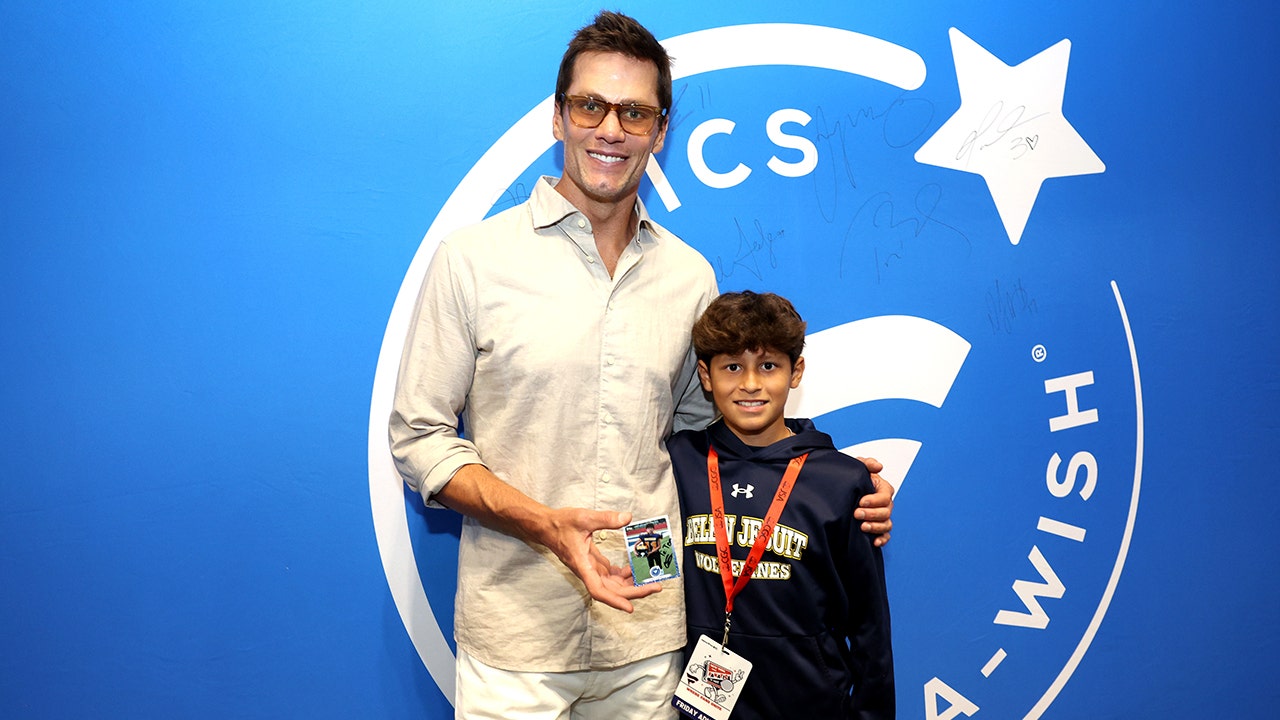
Fans of all ages are trying to meet their sports heroes at Fanatics Fest in New York City this weekend, but 12-year-old Chris Sanchez had a special surprise waiting for him on Friday morning.
He got some one-on-one time with NFL legend Tom Brady.
Through the Make-A-Wish Foundation and Fanatics, the official sports partner of the iconic nonprofit, Sanchez’s wish to meet one of the greatest quarterbacks in NFL history came true.
Fanatics delivers life-changing experiences with football hero Tom Brady a Make-A-Wish kid at New York City’s Javits Center during Fanatics Fest. (Getty Images)
Sanchez, alongside his parents, shared a conversation with Brady, and he even caught some passes from the future Hall of Famer. It was an intimate and fulfilling moment for the young Miami native, who has dealt with a cancer-related illness.
Brady spoke to Fox News Digital after his time with Sanchez, where he expressed how important these special moments are for him, just as much as they are for children and their families.
“I think I’ve been fortunate to be a part of Make-A-Wish for a long time, and it’s great to meet the families,” Brady said. “The kids are going through a lot, and I think it just helps everyone keep lots of things into perspective. Just seeing the joy on the kid’s face and the parents’ faces, sometimes they’ve been dealt some tough cards, but it’s great to see their joy and happiness, especially on a cool day of bringing everyone here.
FANATICS, MAKE-A-WISH GET HELP FROM TOM BRADY AMONG OTHER ATHLETES TO KICK OFF GROUNDBREAKING PARTNERSHIP
“All the sports fans from around the world coming [here], a lot of athletes coming. Trying to create something really unique and special for the fan experience for sure.”
Brady also revealed some advice that he offered Sanchez, who asked a very specific question to the seven-time Super Bowl champion about his own football career.
“He actually asked me, ‘What do you do when you’re a backup? And how do you continue to help the team as a backup?’”
Brady explained to Sanchez, who signed his own trading card for his hero, “When you’re a backup, and you’re not in the position you want to be in, that could either really motivate you and inspire you to do better, or it can be very disappointing and sad. If it’s disappointing and sad, and it doesn’t force you to work harder, then it’s a negative. If you use for learning, it’s a positive.
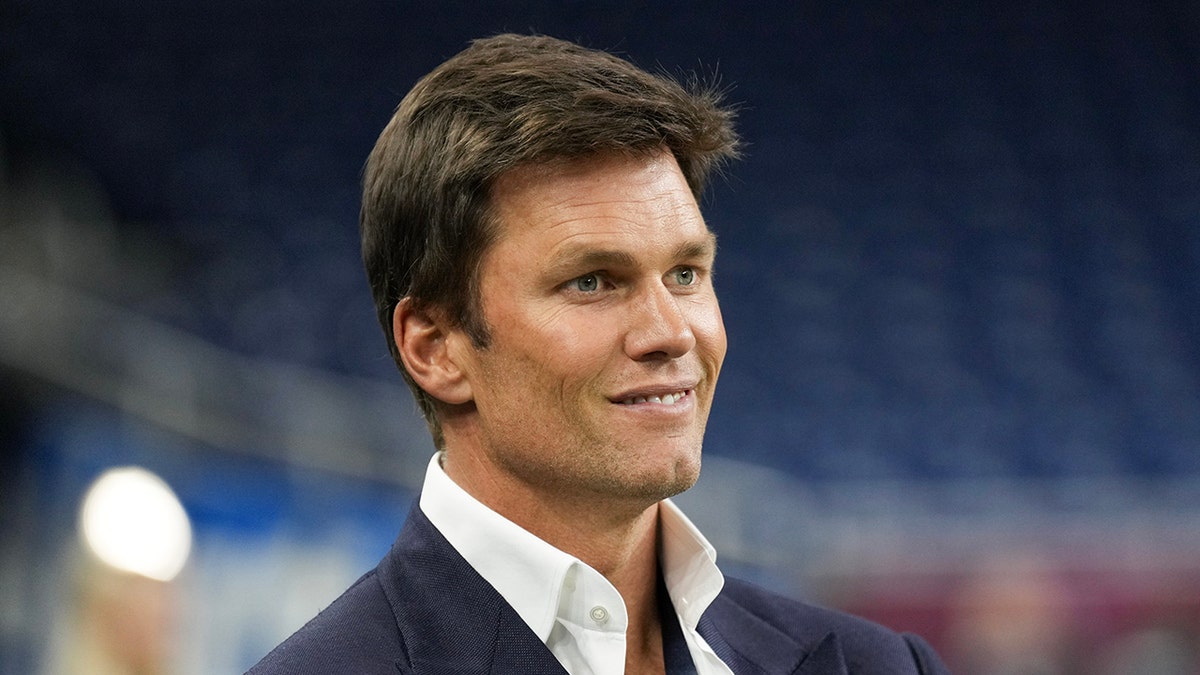
Former NFL quarterback Tom Brady looks on prior to a game between the Michigan Panthers and the Memphis Showboats at Ford Field on May 18, 2024, in Detroit, Michigan. (Nic Antaya/UFL/Getty Images)
“We’re all faced with challenges and adversities. In a personal way, all the families and children are challenged, but they still have goals and dreams, too, that they want to achieve. Just want to try to help them do that.”
Brady added that “everything hits you different as a parent,” being a father of three himself. Wanting his own kids to be around positive influences, Brady knows he can provide that for kids like Sanchez, saying, “You understand the impact you can have speaking to kids.”
Before his time with his sports hero, Sanchez, along with 10-year-old Boston-based Chris Hohn, who met another New England legend in Red Sox slugger David Ortiz for his wish, got to kick his morning off with a private shopping experience at the Fanatics Superstore on premise.
Each kid was gifted a $250 voucher to shop official league, team and player apparel before getting their meet-and-greet opportunity.
Fanatics Fest was created to bring sports fans together under one roof, where they can hopefully create memories that will last a lifetime with some of the greatest players in their respective sports.
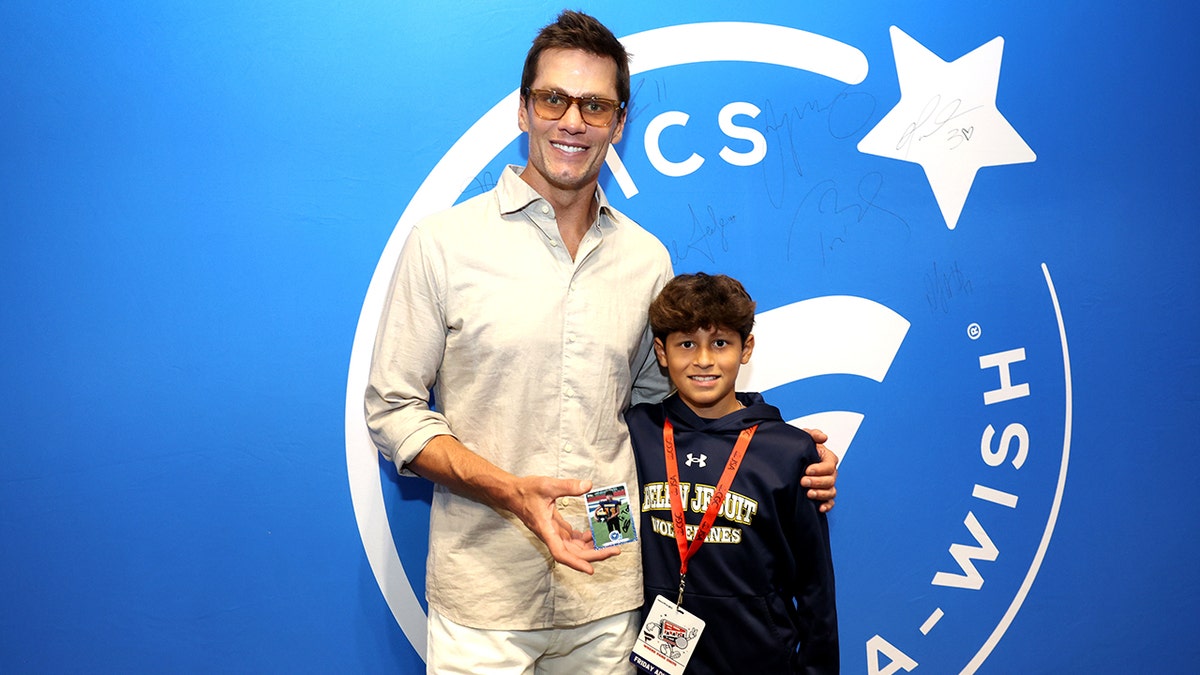
Fanatics delivers life-changing experiences with football hero Tom Brady a Make-A-Wish kid at New York City’s Javits Center during Fanatics Fest. (Getty Images)
That’s exactly what happened with Sanchez, who can forever say he got to speak with, and catch a ball from, Brady.
Follow Fox News Digital’s sports coverage on X, and subscribe to the Fox News Sports Huddle newsletter.
Sports
Ranking ACC basketball programs as a generational talent and three new teams join the conference

College basketball preseason trips are already underway. (We hear the Bahamas are lovely this time of year, Louisville. Shame our invite got lost!) That’s our sign that rosters are basically finalized, and it’s finally worth asking the question:
How’s the ACC looking?
If nothing else, larger. Cal, Stanford, and SMU are now officially members, meaning the 18-team “Atlantic Coast” Conference stretches the width of the United States and the length of the East Coast. But the league has plenty to boast about. No conference has sent more teams to the Final Four the past three seasons than the ACC (four), with four different programs — North Carolina, Duke, Miami, and NC State — each making an appearance. As for the future, the ACC is bringing in nine five-star freshmen, the most of any conference — and more than the Big 12 and Big East combined. The conference has four of the nation’s top 15 recruiting classes, per 247Sports: No. 1 Duke, No. 7 Miami, No. 8 UNC, and No. 14 Georgia Tech. Two others, Clemson and Notre Dame, crack the top 25.
The transfer portal was less kind to the league, though there are still plenty of contributors coming in. But of The Athletic’s top 100 transfers, none of the top 15 joined the ACC. Only 13 of the top 100 best-available players picked ACC schools, with no league member ranking in the top 20 nationally in transfer portal hauls.
Still, the league has plenty of experience, with some of its teams built more around experienced stars. A third of the ACC has at least four players with more than 2,000 career Division I minutes, and nine different teams have at least one player with more than 3,000.
Balance that with three new coaches — Pat Kelsey (Louisville), Andy Enfield (SMU), and Kyle Smith (Stanford) — and there is plenty to look forward to this ACC season. Here’s how we see it all shaking out, with a deeper look at every team’s roster.
1. Duke
Biggest losses: Kyle Filipowski (16.4 ppg, 8.3 rpg); Jared McCain (14.3 ppg, 5 rpg); Jeremy Roach (14 ppg, 3 apg); Mark Mitchell (11.6 ppg, 6 rpg)
Returning rotation players: Tyrese Proctor (10.5 ppg, 3.7 apg); Caleb Foster (7.7 ppg)
Top 100 freshmen added: No. 1 Cooper Flagg, No. 6 Khaman Maluach, No. 14 Isaiah Evans, No. 18 Kon Knueppel, No. 26 Patrick Ngongba II, No. 39 Darren Harris
Top 100 transfers added: None
Why they’re here: How can a team that lost its top four scorers and returns only two rotation players top our rankings? Because of who it’s bringing in, starting with Flagg, the No. 1 recruit in the country. The Maine native has long been viewed as a generational talent. He should be on campus only about nine months, before likely becoming the top pick in the 2025 draft.
That explains many of Jon Scheyer’s offseason roster moves. The third-year coach offloaded several high-profile recruits, including four former five-stars, in favor of plug-and-play transfers who complement Flagg’s skill set. In comes Mason Gillis (Purdue), the reigning Big Ten Sixth Man of the Year and a career 40.7 percent 3-point shooter with national championship game experience. Maliq Brown (Syracuse), an All-ACC defender; and Sion James (Tulane), a wrecking ball of a wing who has played almost 4,000 D-I minutes, also arrived. Then there’s the rest of Duke’s elite recruiting class, including four other five-star talents — like Maluach, the raw 7-foot-2 South Sudanese center who just appeared in the Olympics — to round out the rotation. Proctor and Foster need to stay healthy after missing time last season. If they do? Duke has the experience, top-end talent and role definition necessary to make a national championship run.
GO DEEPER
Nice to meet you: All the new (and old) names to know in the SEC
2. North Carolina
Biggest losses: Armando Bacot (14.5 ppg, 10.3 rpg); Harrison Ingram (12.2 ppg, 8.8 rpg); Cormac Ryan (11.5 ppg)
Returning rotation players: RJ Davis (21.2 ppg, 3.5 apg); Elliot Cadeau (7.3 ppg, 4.1 apg); Seth Trimble (4.2 ppg); Jae’Lyn Withers (4.2 ppg, 3.6 rpg); Jalen Washington (3.9 ppg)
Top 100 freshmen added: No. 8 Ian Jackson, No. 11 Drake Powell, No. 89 James Brown
Top 100 transfers added: No. 16 Cade Tyson (Belmont)
Why they’re here: You can’t do better than bringing back a first-team All-American guard like Davis, arguably the best returning player in all of college basketball. Losing three other starters, including Bacot, stings, but Davis alone raises the ceiling in Chapel Hill. With him, Cadeau, Trimble and top-10 recruit Jackson — already earning rave reviews this summer from the coaching staff — UNC should have one of the best perimeter groups in the sport.
Add in Tyson, a career 44.6 percent 3-point shooter, and Powell, who could be the team’s best defender from Day 1, and Hubert Davis’ team is set on the wings. The frontcourt is where things get a little hairier. UNC added Ven-Allen Lubin (Vanderbilt) late in the portal window to fortify its interior, and either he or Washington needs to emerge as an every-game starting center. If so, then the Tar Heels can challenge rival Duke for the conference title — and there’s no telling how far Davis can take UNC in March.
Career Division I minutes on roster
| Team | Minutes |
|---|---|
|
20,677 (5 players with 2,000-plus) |
|
|
18,252 (5 players with 2,000-plus) |
|
|
16,988 (5 players with 2,000-plus) |
|
|
15,869 (4 players with 2,000-plus) |
|
|
15,236 (4 players with 2,000-plus) |
|
|
14,876 (2 players with 2,000-plus) |
|
|
13,246 (4 players with 2,000-plus) |
|
|
13,221 (3 players with 2,000-plus) |
|
|
12,538 (3 players with 2,000-plus) |
|
|
12,111 (2 players with 2,000-plus) |
|
|
12,007 (3 players with 2,000-plus) |
|
|
11,929 (one player with 2,000-plus) |
|
|
9,859 (2 players with 2,000-plus) |
|
|
9,063 (one player with 2,000-plus) |
|
|
8,466 (2 players with 2,000-plus) |
|
|
8,077 (1 player with 2,000-plus) |
|
|
6,182 (1 player with 2,000-plus) |
|
|
5,456 (1 player with 2,000-plus) |
3. Louisville
Biggest losses: Skyy Clark (13.2 ppg); Brandon Huntley-Hatfield (12.9 ppg, 8.4 rpg); Mike James (12.6 ppg, 5 rpg); Tre White (12.3 ppg, 5.9 rpg); JJ Traynor (10.1 ppg, 4.6 rpg); Ty-Laur Johnson (8.7 ppg, 3.6 apg); Curtis Williams (5.3 ppg); Kaleb Glenn (3.9 ppg)
Returning rotation players: None
Top 100 freshmen added (1): No. 34 Khani Rooths
Top 100 transfers added (4): No. 17 Terrence Edwards Jr. (James Madison), No. 46 Chucky Hepburn (Wisconsin), No. 61 J’Vonne Hadley (Colorado), No. 70 Kasean Pryor (South Florida)
Why they’re here: Can you rebuild a whole program in a single offseason? We’re about to find out, with Louisville as the national test case. The Cardinals got rid of their coach, their entire roster and somehow still ended up with the most experienced and productive group of players in the ACC.
Pat Kelsey’s team leads the league in D-I minutes played, career made 3s and top 100 transfers added — but no one, obviously, has done anything in a UL uniform. Still, having five players with over 2,000 career D-I minutes, plus five who have made at least 50 career 3s, should be a boon for Kelsey’s 3-point happy offense. In Kelsey’s 12 years as head coach, his teams have finished in the top 75 in 3-point rate 10 times — including last season, when College of Charleston finished 17th nationally after taking 46.9 percent of its shots from deep.
Among the notable additions: Edwards, the Sun Belt Player of the Year who led JMU to a program-best 32 wins; Hepburn, an All-Big Ten defender and three-year starter; and Pryor, who led USF to 21 wins in 22 games last season after becoming a starter. This ranking is admittedly a gamble on Kelsey getting all the players to coalesce, but Louisville has the talent to make one of the biggest year-to-year leaps in the sport — and get back to the NCAA Tournament.
4. Miami
Biggest losses: Norchad Omier (17 ppg, 10 rpg); Wooga Poplar (13.1 ppg, 4.8 rpg); Bensley Joseph (9.6 ppg); Kyshawn George (7.6 ppg)
Returning rotation players: Matthew Cleveland (13.7 ppg, 6.1 rpg); Nijel Pack (13.3 ppg, 3.6 apg)
Top 100 freshmen added: No. 7 Jalil Bethea, No. 50 Austin Swartz
Top 100 transfers added: No. 84 Brandon Johnson (East Carolina), No. 91 Lynn Kidd (Virginia Tech)
Why they’re here: Last season’s Final Four encore was a train wreck as the Hurricanes struggled with injuries and depth. Losing Norchad Omier, a walking double-double and the program’s only real big man, was a tough blow, too. But Jim Larrañaga never stays down for long, proving it by hanging onto his best two perimeter players, signing the program’s highest-ranked recruit in nearly four decades, and adding much-needed, missing depth via the portal.
Including Pack and Cleveland, Miami has five players with at least 50 career made 3s — which ties the league lead — and that’s before factoring in Bethea, a knockdown shooter and projected lottery pick in next year’s NBA Draft. Kidd and Johnson add necessary size in the frontcourt, and Johnson can stretch the floor in ways Omier couldn’t. Don’t sleep on Jalen Blackmon (Stetson), either. Not only did the 6-3 guard average 21.3 points per game last season, the 14th-most in D-I, but he dropped 43 in the Atlantic Sun title game to send the Hatters to their first NCAA Tournament. The Hurricanes may be undersized again — par for the course lately under Larrañaga — and struggle defensively because of it, but all the pieces are there for another top-50 offense, plus a return to the Big Dance.
Biggest losses: Kevin “Boopie” Miller (15.6 ppg); Andrew Carr (13.5 ppg, 6.8 rpg); Damari Monsanto (5.1 ppg)
Returning rotation players: Hunter Sallis (18 ppg, 4.1 rpg); Cameron Hildreth (13.8 ppg, 4.7 rpg); Efton Reid III (9.6 ppg, 7.6 rpg); Parker Friedrichsen (5.1 ppg);
Top 100 freshmen added: No. 88 Juke Harris
Top 100 transfers added: None
Why they’re here: Only two first- or second-Team All-ACC players from last season are returning: Davis at UNC and Sallis at Wake Forest. The former five-star recruit pulled his name out of the NBA Draft — where he likely would’ve been a first-round pick — at the last minute, giving Steve Forbes the best returner he’s had yet in Winston-Salem.
That also means expectations in Forbes’ fifth season will be as high as ever. Making the NCAA Tournament, which the Demon Deacons have been close to the past three seasons, is paramount. That’s feasible with Sallis and two other starters back: Hildreth, one of the league’s craftier guards, and Reid, another former five-star recruit who stabilizes the frontcourt. Given Forbes’ track record in the transfer portal, we’re betting on big things from at least one of his additions. Maybe Omaha Biliew (Iowa State), another former five-star who could start at power forward? Or possibly Tre’Von Spillers (Appalachian State), who was named All-Sun Belt in his first season of D-I ball? Either way, with five of its top eight players back from last season — tied with UNC for the second-most in the ACC — Wake Forest has a strong enough foundation to get over the hump for the first time in the Forbes era.
Career made 3-pointers on roster
| Team | 3-pointers |
|---|---|
|
853 (5 players with 50-plus) |
|
|
755 (5 players with 50-plus) |
|
|
685 (5 players with 50-plus) |
|
|
515 (3 players with 50-plus) |
|
|
512 (4 players with 50-plus) |
|
|
489 (3 players with 50-plus) |
|
|
476 (4 players with 50-plus) |
|
|
471 (3 players with 50-plus) |
|
|
427 (2 players with 50-plus) |
|
|
416 (4 players with 50-plus) |
|
|
394 (4 players with 50-plus) |
|
|
373 (3 players with 50-plus) |
|
|
344 (2 players with 50-plus) |
|
|
299 (2 players with 50-plus) |
|
|
261 (3 players with 50-plus) |
|
|
252 (2 players with 50-plus) |
|
|
201 (0 players with 50-plus) |
|
|
185 (1 player with 50-plus) |
Biggest losses: Blake Hinson (18.5 ppg, 4.4 rpg); Carlton “Bub” Carrington (13.8 ppg, 5.2 rpg, 4.1 apg); Federiko Federiko (4.7 ppg, 5.2 rpg)
Returning rotation players: Ishmael Leggett (12.3 ppg, 5.5 rpg); Jaland Lowe (9.6 ppg); Guillermo Diaz Graham (6.7 ppg); Zack Austin (6.5 ppg, 4.2 rpg); Jorge Diaz Graham (3.5 ppg)
Top 100 freshmen added: None
Top 100 transfers added: None
Why they’re here: Carrington, a surprise one-and-done, was Pitt’s best freshman last season, but Lowe — who averaged 13.1 points, 4.1 assists and 3.6 rebounds per game in his 19 games as a starter — wasn’t far behind. He could become a bona fide all-league player, and he’s already earning buzz as a potential first-round pick. Lowe’s the ideal set-up man for Pitt’s various returners, especially Leggett, the reigning ACC Sixth Man of the Year who dropped 30 points in the conference semifinals.
As for new arrivals, Damian Dunn (Houston) is finally free from Kelvin Sampson’s doghouse and can hopefully return to the potent scoring form (14.6 ppg) he showed in four seasons at Temple. Forward Cam Corhen (Florida State) provides another frontcourt presence who should thrive in pick-and-rolls with Lowe and Leggett. Jeff Capel’s team is in the top third of the league in career made 3s, and if it can capitalize on that shooting proficiency — like it did late last season, winning 10 of its final 13 games — then a second NCAA Tournament berth in three seasons is within reach.
7. Georgia Tech
Biggest losses: Miles Kelly (13.9 ppg, 5.5 rpg); Kyle Sturdivant (8.8 ppg); Dallan Coleman (5.9 ppg); Tafara Gapare (5.1 ppg); Tyzhaun Claude (4.8 ppg, 5.2 rpg); Amaree Abram (3.4 ppg)
Returning rotation players: Baye Ndongo (12.4 ppg, 8.2 rpg); Naithan George (9.8 ppg, 4.7 apg); Kowacie Reeves Jr. (9.8 ppg, 3.9 rpg); Lance Terry (10.1 ppg in 2022-23)
Top 100 freshmen added: No. 59 Jaeden Mustaf
Top 100 transfers added: No. 33 Javian McCollum (Oklahoma)
Why they’re here: This is higher than you’ll find the Yellow Jackets in other preseason rankings, but we’re calling our shot with Damon Stoudamire’s second squad: This team can make the NCAA Tournament. Georgia Tech returns three of its top four players, but most important among them are Ndongo — who posted the program’s best freshman stats since Chris Bosh and Derrick Favors — and George, who had the fourth-best assist rate in the ACC last season. Reeves is a highlight reel in waiting on the wing, and Terry, who missed all of last season with a calf injury, is a career 37.2 percent 3-point shooter who can prevent defenses from collapsing on Ndongo inside.
But McCollum is the other reason to be excited about GT. The nation’s second-best free-throw shooter last season (94.3 percent) is a pick-and-roll maestro who led the Sooners in scoring, and that’s even after his 3-point shot cratered in OU’s final 15 games. McCollum shot 39.8 percent from 3 in Oklahoma’s first 15 games … and 21.5 percent over its last 15. With him and George in the backcourt, pick-and-rolls with Ndongo should be as potent as any in the ACC. The Yellow Jackets are young — 11th in the ACC in D-I minutes — but should be fun.
8. Clemson
Biggest losses: PJ Hall (18.3 ppg, 6.4 rpg); Joseph Girard III (15.1 ppg); RJ Godfrey (6.1 ppg); Alex Hemenway (5.2 ppg); Jack Clark (4.7 ppg, 4.9 rpg)
Returning rotation players: Chase Hunter (12.9 ppg, 3.2 apg); Ian Schieffelin (10.1 ppg, 9.4 rpg); Chauncey Wiggins (5.4 ppg); Dillon Hunter (2.3 ppg)
Top 100 freshmen added: No. 79 Dallas Thomas
Top 100 transfers added: None
Why they’re here: There’s no sugarcoating the losses of Hall and Girard, who led or tied for the team lead in scoring 29 times in 36 games. They were the heart of Clemson’s Elite Eight team. But if there is good news, it’s that Hunter — who averaged 17.8 points, 5.8 assists, 4.3 rebounds, and 2 steals per game in four NCAA Tournament contests — is back for his sixth season of college hoops.
Moving from third to first on the opposing scouting report is no easy jump, but with Hunter and Schieffelin, the ACC’s Most Improved Player, back, Clemson has a solid floor. Those are two of the five Tigers with at least 2,000 D-I minutes, tied for the most in the league. But how will the other three — Jaeden Zackery (Boston College), Jake Heidbreder (Air Force), and Myles Foster (Illinois State) — acquit themselves? Probably well, but we wonder if they’ll be as impactful and consistent as the players Clemson lost.

GO DEEPER
Players, coaches, collective reps talk NIL: College basketball confidential
Biggest losses: Reece Beekman (14.3 ppg, 6.2 apg); Ryan Dunn (8.1 ppg, 6.9 rpg); Jacob Groves (7.4 ppg); Jordan Minor (4.3 ppg)
Returning rotation players: Isaac McKneely (12.3 ppg); Andrew Rohde (4.3 ppg); Blake Buchanan (3.4 ppg); Taine Murray (3.3 ppg)
Top 100 freshmen added: No. 87 Jacob Cofie
Top 100 transfers added: No. 89 TJ Power (Duke)
Why they’re here: With Virginia ranked this low, it’s fair to have the reaction: Is Tony Bennett not Virginia’s coach anymore? He is, and placing his team this low — considering the Cavaliers have finished top-three in the league eight times in the past 10 seasons — feels odd. But while UVa leaned into the transfer portal more fully this offseason, it still feels like the Cavaliers might be a player or two short.
McKneely, a top-50 shooter nationally last season, at least provides one guarantee, a potential all-league player with experience in Bennett’s system. Beyond that? Power is probably Virginia’s best hope for a second star, but how he’ll fare defensively is unclear. Elijah Saunders (San Diego State) and Jalen Warley (Florida State) come from defensive-minded programs, so they should make an immediate impact, but neither is an offensive dynamo. There’s a lot of projecting fit here, considering only Warley has played 2,000 career minutes, and only McKneely and Rohde — who looked out of his depth much of his first season in Charlottesville — have made 50 career 3s. Defense shouldn’t be the issue; offense, we’re in wait-and-see mode.
Returning top-8 players (by minutes)
| Team | |
|---|---|
|
No. 1, No. 2, No. 3, No. 4, No. 5, No. 6, No. 8 |
|
|
No. 1, No. 2, No. 5, No. 6, No. 8 |
|
|
No. 1, No. 5, No. 6, No. 7, No. 8 |
|
|
No. 2, No. 4, No. 5, No. 8 |
|
|
No. 2, No. 4, No. 6, No. 8 |
|
|
No. 3, No. 4, No. 5, No. 7 |
|
|
No. 3, No. 4, No. 7, No. 8 |
|
|
No. 2, No. 6, No. 7 |
|
|
No. 2, No. 3, No. 4 |
|
|
No. 1, No. 4, No. 7 |
|
|
No. 7, No. 8 |
|
|
No. 4, No. 6 |
|
|
No. 2, No. 7 |
|
|
No. 2, No. 5 |
|
|
No. 3, No. 7 |
|
|
No. 7 |
|
|
No. 8 |
|
|
None |
10. NC State
Biggest losses: DJ Horne (16.9 ppg); DJ Burns (12.9 ppg, 4 rpg); Casey Morsell (11.1 ppg); Mohammed Diarra (6.3 ppg, 7.8 rpg)
Returning rotation players: Jayden Taylor (11.2 ppg, 3.6 apg); Ben Middlebrooks (5.7 ppg, 4.4 rpg); Michael O’Connell (5.7 ppg, 3.2 apg); Dennis Parker (4.7 ppg)
Top 100 freshmen added: No. 56 Paul McNeil
Top 100 transfers added: No. 50 Brandon Huntley-Hatfield (Louisville)
Why they’re here: NC State’s epic postseason DJs, Horne and Burns, are both gone, and there’s no replicating the magic those two conjured in March. But Kevin Keatts capitalized on the Wolfpack’s Final Four berth as best he could. That started with retention. Keatts brought back ACC Tournament hero O’Connell as his full-time point guard, Taylor as his top shooter and Middlebrooks as his backup big. Landing Huntley-Hatfield — who should slide into (part of) NC State’s Burns-sized hole at center — was huge, too, and should allow the Wolfpack to be more versatile defensively.
Dontrez Styles (Georgetown) and Mike James (Louisville) put up big numbers on bad teams, and Marcus Hill (Bowling Green) was productive but inefficient. How those three adjust — or don’t — to more clearly defined roles should determine if the Wolfpack can make a third straight NCAA Tournament.
11. Syracuse
Biggest losses: Judah Mintz (18.8 ppg, 4.4 apg); Quadir Copeland (9.6 ppg, 4.6 rpg); Maliq Brown (9.5 ppg, 7.2 rpg); Justin Taylor (5 ppg, 4 rpg)
Returning rotation players: J.J. Starling (13.3 ppg); Chris Bell (12 ppg); Naheem McLeod (3.9 ppg, 4.3 rpg)
Top 100 freshmen added: No. 13 Donnie Freeman, No. 99 Elijah Moore
Top 100 transfers added: None
Why they’re here: Adrian Autry did about as well as expected in his first season: a 20-12 record, plus a top-85 offense and defense, per KenPom’s adjusted efficiency rankings. But that was mostly with Jim Boeheim’s old players. Now, Autry’s fingerprints are all over his second roster.
Starling and Bell are back as perimeter starters, and Bell — a 41.7 percent 3-point shooter last season — must carry the Orange from behind the arc. Freeman should snap the program’s NBA Draft dry spell — The Athletic’s Sam Vecenie listed him 12th on his initial 2025 big board — but hopefully not before making a major impact as a two-way college forward. It would not be a surprise if he ends up being Syracuse’s best player.
Two-time All-CAA wing Jyare Davis (Delaware) should be Autry’s most impactful transfer, although Eddie Lampkin Jr. (Colorado) provides size the Orange have lacked for several seasons. There’s an NCAA Tournament team here if all the new elements take, but it could also take Autry another year to get the program where he wants it.
12. Notre Dame
Biggest losses: Carey Booth (6.4 ppg, 4.3 rpg); Matt Zona (2.3 ppg)
Returning rotation players: Markus Burton (17.5 ppg, 4.3 apg); Braeden Shrewsberry (10.2 ppg); Tae Davis (9.2 ppg, 5.1 rpg); J.R. Konieczny (7.7 ppg, 4.5 rpg); Julian Roper II (5.4 ppg, 4 rpg); Kebba Njie (4.3 ppg, 5.4 rpg); Logan Imes (2 ppg)
Top 100 freshmen added: No. 68 Sir Mohammed
Top 100 transfers added: None
Why they’re here: Development is the mantra. The Fighting Irish, the sixth-youngest team in D-I last season, return seven of their top eight players from Micah Shrewsberry’s debut team. That’s the most in the league; no other program returns more than five.
Keeping Burton around gives Notre Dame one of the league’s highest-upside backcourts, and both guards should improve after taking their lumps as freshmen. But the Irish have only one player with 2,000 career minutes — sharpshooter Matt Allocco (Princeton), the team’s top incoming transfer — which is tied for the fewest in the ACC. The program is probably still a year or two away from being truly competitive, but Shrewsberry is quickly closing the gap.
13. SMU
Biggest losses: Zhuric Phelps (14.8 ppg, 4.1 rpg); Samuell Williamson (8.3 ppg, 7.1 rpg); Tyreek Smith (8.2 ppg, 5.4 rpg); Ricardo Wright (6.7 ppg); Jalen Smith (5.9 ppg); Ja’Heim Hudson (5.4 ppg)
Returning rotation players: Chuck Harris (13.4 ppg); Keon Ambrose-Hylton (6.9 ppg, 4.2 rpg); B.J. Edwards (3.7 ppg)
Top 100 freshmen added: None
Top 100 transfers added: No. 94 Kevin “Boopie” Miller (Wake Forest)
Why they’re here: Like Louisville, SMU is another fascinating test of what’s possible in the span of one offseason. The Mustangs have the second-most career minutes played of any ACC team, the third-most career 3-pointers, but four of their five most-experienced players arrived as transfers this spring.
Miller and Harris form an undersized but high-usage backcourt, and they’ll need to be the offensive drivers for Andy Enfield’s first team in Dallas. Yohan Traore (UC Santa Barbara) always had potential, but can he finally capitalize on it at his third school in three seasons? There is enough here to be competitive, but amid the competition jump from the American, unwieldy travel logistics, a new coach and so many moving pieces, it’s difficult to imagine SMU thriving right away.
14. California
Biggest losses: Jaylon Tyson (19.6 ppg, 6.8 rpg); Fardaws Aimaq (14.5 ppg, 11 rpg); Jalen Cone (13.4 ppg); Keonte Kennedy (9.3 ppg, 4.7 rpg); Jalen Celestine (8.7 ppg)
Returning rotation players: None
Top 100 freshmen added: None
Top 100 transfers added (2): No. 71 Andrej Stojakovic (Stanford), No. 92 Rytis Petraitis (Air Force)
Why they’re here: Not that you’d want to keep everyone from a 13-19 team, but losing your top seven players is never ideal. That made adding two top 100 transfers — which somehow ties for the second-most in the ACC — necessary.
Stojakovic is the biggest name here, given his bloodline and high school pedigree, but he was hit-or-miss as a freshman, making just 32.7 percent of his 3s. Petraitis is just as interesting, though, having played largely as a small-ball center despite being only 6-foot-7 and 210 pounds. He’s a creative passer, and we can already picture him finding All-Summit forward B.J. Omot (North Dakota) on backdoor cuts. The overall talent level isn’t at an ACC level, but Mark Madsen is a smart coach. We doubt Cal just rolls over.

GO DEEPER
Peach Jam intel: Cam Boozer or AJ Dybantsa? Plus 10 more standouts
15. Virginia Tech
Biggest losses: Sean Pedulla (16.4 ppg, 4.6 apg, 4.3 rpg); Hunter Cattoor (13.5 ppg); Lynn Kidd (13.2 ppg, 6.5 rpg); Tyler Nickel (8.8 ppg); MJ Collins (7.4 ppg); Robbie Beran (5.6 ppg); Mekhi Long (3.7 ppg, 4.9 rpg)
Returning rotation players: Mylyjael Poteat (6.4 ppg)
Top 100 freshmen added: No. 80 Ryan Jones Jr.
Top 100 transfers added: None
Why they’re here: It was not a fun offseason for Virginia Tech. The Hokies lost seven of their top eight players — including all five starters and their sixth man — from a 19-15 squad that could’ve been competitive had it stayed together. VT has one player with over 2,000 career minutes, Hysier Miller (Temple), and while he’s a capable pick-and-roll guard, his inefficiency will be something Mike Young has to manage. Otherwise, it’s a lot of young lottery tickets for Young, who must hope for one or two hits. Jaden Schutt (Duke) could be a sneaky name to watch, filling the off-ball shooting role long occupied by Cattoor, but Young will have to get creative offensively for this team to remain competitive.
16. Boston College
Biggest losses: Quinten Post (17 ppg, 8.1 rpg); Claudell Harris Jr. (13.7 ppg); Jaeden Zackery (11.3 ppg, 4.2 apg); Devin McGlockton (10.2 ppg, 6.3 rpg); Mason Madsen (8.1 ppg)
Returning rotation players: Donald Hand Jr. (5 ppg); Chas Kelley III (3.7 ppg)
Top 100 freshmen added: None
Top 100 transfers added: None
Why they’re here: Earl Grant steadily built BC into a 20-win team last season, earning the program’s best KenPom finish since 2011, only for his top six players to leave, setting the Eagles back to square one. With no incoming top 100 freshmen or transfers, Grant had to piece together a roster that’s hard to be too excited about. Dion Brown (UMBC) is an intriguing young pickup who Grant should largely give the keys to, and Chad Venning (St. Bonaventure) has the size to bang with ACC bigs, but that isn’t enough to continue the momentum Grant was building.
17. Stanford
Biggest losses: Brandon Angel (13 ppg, 4.7 rpg); Spencer Jones (11.7 ppg, 4.1 rpg); Kanaan Carlyle (11.5 ppg); Michael Jones (10.8 ppg); Andrej Stojakovic (7.8 ppg); Jared Bynum (6.9 ppg, 5.2 apg)
Returning rotation players: Maxime Raynaud (15.5 ppg, 9.6 rpg); Benny Gealer (4.2 ppg)
Top 100 freshmen added: None
Top 100 transfers added: None
Why they’re here: Getting Raynaud, the Pac-12’s Most Improved Player, back was imperative for new coach Kyle Smith. Raynaud is the only player on the roster with more than 1,400 career minutes, and one of only two with more than 800, joining Chisom Okpara (Harvard). Stanford’s young squad also will probably struggle to shoot it; the Cardinal are the only ACC team without a single player who has made at least 50 career 3-pointers. Unsurprisingly, Stanford as a team also has the second-fewest career made 3s, with little help on the way. Rebuilds have to start somewhere, and Smith has flipped a program before, but it’s going to take time.
18. Florida State
Biggest losses: Darin Green Jr. (11.3 ppg); Primo Spears (10.6 ppg); Cameron Corhen (9.4 ppg); Baba Miller (7.6 ppg, 4.9 rpg); Jalen Warley (7.5 ppg); Cam’Ron Fletcher (6.7 ppg, 5 rpg)
Returning rotation players: Jamir Watkins (15.6 ppg, 6 rpg); Chandler Jackson (4.9 ppg); Taylor Bol Bowen (3.1 ppg)
Top 100 freshmen added: No. 84 Alier Maluk
Top 100 transfers added: None
Why they’re here: Two lost seasons in a row for FSU, and a third seems almost inevitable. Leonard Hamilton lost six of his top eight players this offseason, and their transfer portal replacements aren’t the same caliber. Watkins is a tremendous player, but there may not be anyone in the ACC who has to do more for his team next season than he will. Not only is Watkins FSU’s only player with over 2,000 career minutes, but he’s also the only of the Seminoles with at least 50 made 3s — which is a large part of why Hamilton’s team is last in the ACC in career 3s. Hamilton is a great coach, one of the most underappreciated in the sport, but it’ll take his best coaching job to get this version of FSU to even the middle of the league standings.
(Photo of Tyrese Proctor: Lance King / Getty Images)
-
News1 week ago
The ‘Blue Walz’: How a low-key Midwestern governor shot to the top to be Harris’ VP pick | CNN Politics
-

 Ohio2 days ago
Ohio2 days agoOhio taxpayers sent families $966 million for private school tuition: Capitol Letter
-

 Movie Reviews1 week ago
Movie Reviews1 week ago‘Confession’ Review: A Live-Action Manga Adaptation Crams Maximum Menace Into One Cabin
-

 World1 week ago
World1 week agoThe day after in Dhaka
-

 World1 week ago
World1 week agoEx-Catalan leader Puigdemont headed back to Spain despite fear of arrest
-
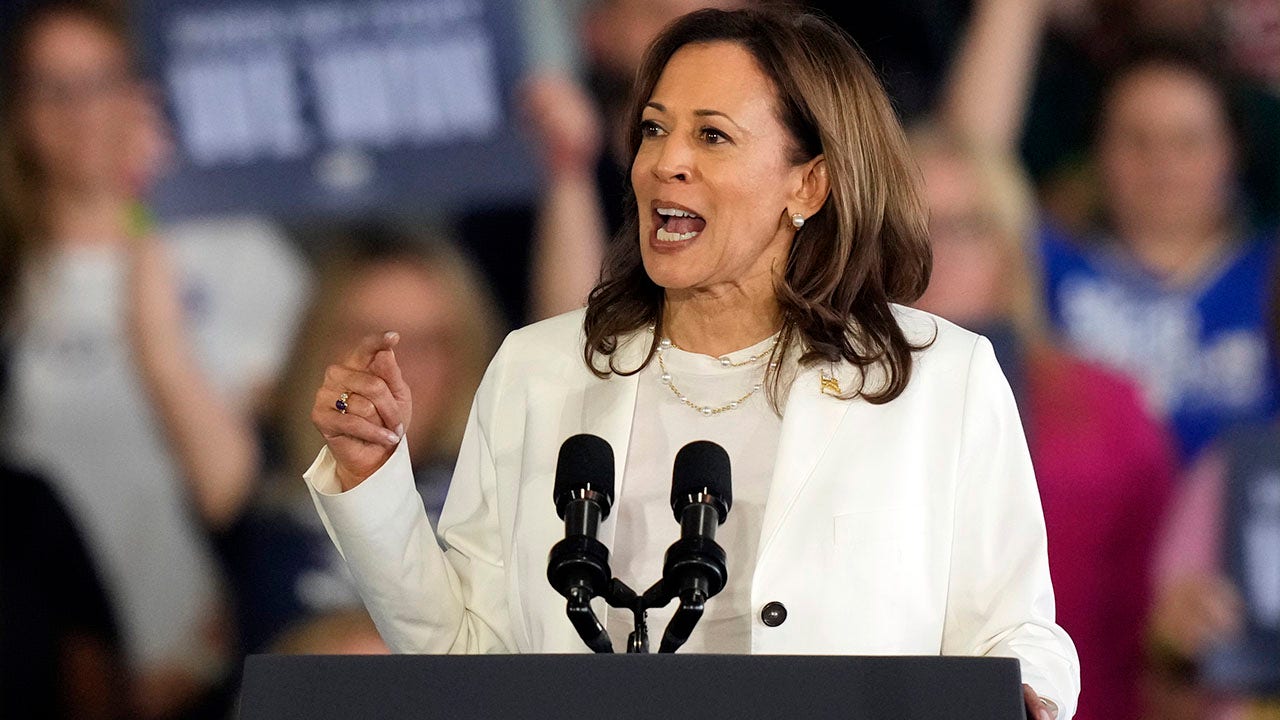
 Politics1 week ago
Politics1 week agoKamala Harris shuts down anti-Israel protesters during campaign speech in Michigan: 'I'm speaking'
-

 Sports1 week ago
Sports1 week agoWhat’s in a name (change)? For Josh Hines-Allen, it was about roots and recognition
-

 News1 week ago
News1 week agoMap: 5.2-Magnitude Earthquake Strikes Southern California



